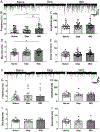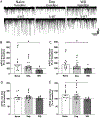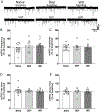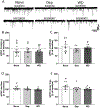Withdrawal from chronic alcohol impairs the serotonin-mediated modulation of GABAergic transmission in the infralimbic cortex in male rats
- PMID: 38996987
- PMCID: PMC11412312
- DOI: 10.1016/j.nbd.2024.106590
Withdrawal from chronic alcohol impairs the serotonin-mediated modulation of GABAergic transmission in the infralimbic cortex in male rats
Abstract
The infralimbic cortex (IL) is part of the medial prefrontal cortex (mPFC), exerting top-down control over structures that are critically involved in the development of alcohol use disorder (AUD). Activity of the IL is tightly controlled by γ-aminobutyric acid (GABA) transmission, which is susceptible to chronic alcohol exposure and withdrawal. This inhibitory control is regulated by various neuromodulators, including 5-hydroxytryptamine (5-HT; serotonin). We used chronic intermittent ethanol vapor inhalation exposure, a model of AUD, in male Sprague-Dawley rats to induce alcohol dependence (Dep) followed by protracted withdrawal (WD; 2 weeks) and performed ex vivo electrophysiology using whole-cell patch clamp to study GABAergic transmission in layer V of IL pyramidal neurons. We found that WD increased frequencies of spontaneous inhibitory postsynaptic currents (sIPSCs), whereas miniature IPSCs (mIPSCs; recorded in the presence of tetrodotoxin) were unaffected by either Dep or WD. The application of 5-HT (50 μM) increased sIPSC frequencies and amplitudes in naive and Dep rats but reduced sIPSC frequencies in WD rats. Additionally, 5-HT2A receptor antagonist M100907 and 5-HT2C receptor antagonist SB242084 reduced basal GABA release in all groups to a similar extent. The blockage of either 5-HT2A or 5-HT2C receptors in WD rats restored the impaired response to 5-HT, which then resembled responses in naive rats. Our findings expand our understanding of synaptic inhibition in the IL in AUD, indicating that antagonism of 5-HT2A and 5-HT2C receptors may restore GABAergic control over IL pyramidal neurons. SIGNIFICANCE STATEMENT: Impairment in the serotonergic modulation of GABAergic inhibition in the medial prefrontal cortex contributes to alcohol use disorder (AUD). We used a well-established rat model of AUD and ex vivo whole-cell patch-clamp electrophysiology to characterize the serotonin modulation of GABAergic transmission in layer V infralimbic (IL) pyramidal neurons in ethanol-naive, ethanol-dependent (Dep), and ethanol-withdrawn (WD) male rats. We found increased basal inhibition following WD from chronic alcohol and altered serotonin modulation. Exogenous serotonin enhanced GABAergic transmission in naive and Dep rats but reduced it in WD rats. 5-HT2A and 5-HT2C receptor blockage in WD rats restored the typical serotonin-mediated enhancement of GABAergic inhibition. Our findings expand our understanding of synaptic inhibition in the infralimbic neurons in AUD.
Keywords: Alcohol use disorder; Electrophysiology; GABA; Infralimbic cortex; Patch-clamp; Serotonin.
Copyright © 2024 The Authors. Published by Elsevier Inc. All rights reserved.
Conflict of interest statement
Declaration of competing interest The authors declare no competing financial interests.
Figures








References
-
- Abi-Saab WM, et al. , 1999. 5-HT2 receptor regulation of extracellular GABA levels in the prefrontal cortex. Neuropsychopharmacology 20, 92–96. - PubMed
-
- Arvanov VL, Wang RY, 1998. M100907, a selective 5-HT2A receptor antagonist and a potential antipsychotic drug, facilitates N-methyl-D-aspartate-receptor mediated neurotransmission in the rat medial prefrontal cortical neurons in vitro. Neuropsychopharmacology 18, 197–209. - PubMed
Publication types
MeSH terms
Substances
Grants and funding
LinkOut - more resources
Full Text Sources
Medical

